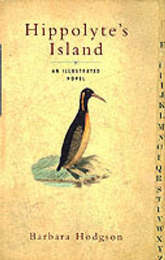
|
Hippolyte's Island: An Illustrated Novel
Hardback
Main Details
| Title |
Hippolyte's Island: An Illustrated Novel
|
| Authors and Contributors |
By (author) Barbara Hodgson
|
| Physical Properties |
| Format:Hardback | | Pages:282 | | Dimensions(mm): Height 235,Width 155 |
|
| Category/Genre | Modern and contemporary fiction (post c 1945) |
|---|
| ISBN/Barcode |
9780811828925
|
| Classifications | Dewey:741.5973 |
|---|
| Audience | | Tertiary Education (US: College) | | General | |
|---|
| Illustrations |
colour and b&w illustrations, maps
|
|
Publishing Details |
| Publisher |
Chronicle Books
|
| Imprint |
Chronicle Books
|
| Publication Date |
23 August 2001 |
| Publication Country |
United States
|
Description
From the author of The Sensualist and The Tattooed Map comes another fascinating work of illustrated fiction. The discovery of a group of lost islands on a centuries-old map sends modern-day explorer Hippolyte Webb on a quest for vanished lands. His adventures in both the South Atlantic and the New York publishing world make for another mysterious tale that unravels to the accompaniment of Barbara Hodgson's one-of-a-kind illustrations. Note that all of the latitude and longitude details are absolutely factual! And all of the historical details are factual as well-- except the story of the sealing boat landing on the Auroras with Robert Runford, Captain Thomas and the Delight.
Author Biography
Barbara Hodgson is a Vancouver-based writer, photographer, and designer. She is the author of the forthcoming the acclaimed illustrated novels The Sensualist and The Tattooed Map, as well as collaborator on Paris Out of Hand, a fictional guidebook to Paris.
ReviewsHippolyte Webb of Vancouver historian, travel consultant, botanist, linguist, and writer has scratched out a living by creating and selling a travel magazine, and when we find him in his rather neglected bachelor pad between trips, we learn about his plant of und his next excursion. He'll sell a book about the venture, he decides, and use the advance to get there. Most of his wandering have been on land, and the more obscure part of the land the better. Nothing heretofore has been on water, for a very simple reason: Webb doesn't know how to sail. But the protagonist of Barbara Hodgson's Hippolyte's Island sure likes sailing maps and charts, the older the better. They fascinate him; in fact, all maps fascinate him, to the point that even when he looks up at his cracked and stained ceiling, he thinks of exotic travel. He calls it his ceilingscape, and as more plaster falls onto his soggy old couch, the resulting patch looks to him not like something that needs immediate repair, but an intriguing dried-out lake bed. His colorful description of the ceilingscape gives the reader an idea of what makes Webb tick: It had already undergone much geological activity. Above stretched a coastline of stains, a three-dimensional terrain of bulges and flakes, charting years of slowly encroaching water damage. Beginning in the east, appropriately at the window, a voyage round this head-over-heels expanse followed a string of long fjords of dampness. Thin tentacles crept out from these inlets, the rivers that seemed to feed them. Continuing to the north, the eye navigated tufty patches of trial paints spackley beige, rippled cream, stalactite eggshell. This adventurer can stay home only so long before he itches to hit the road again. It's obvious that Webb's adventures are more important to him than the condition of his hearth and home, and when his battered old globe disintegrates into two parts, he suddenly takes new interest in South America, because it ends up in his hands while the northern half of the world falls to the floor. Tracing his fingers down to the empty South Atlantic Ocean between the Falklands and the island of South Georgia, he discovers a group of islands the Auroras that are on all his old maps and gloves but none of the new ones. Because no one has written about them for centuries, this is where Webb decides he will travel next. Not deterred by his land of seafaring knowledge, our hero signs up for a quick Sailing 101 course at his local junior high school, charms his female sailing instructor, secures a book advance, charters a 30-foot boat, and heads off, forgetting to learn how to launch the thing. He gets seasick, frightened, and disoriented, and nearly drowns when he decides to dive in for a swim. This is no James Bond on water; Webb is like all the rest of us, it turns out. But he finds his lost islands and, thrilled to be the first to rediscover them, names one of them after himself, admitting it's the most conceited thing he's ever done. It's charming to read about a klutz at sea, and so unusual and unexpected that it adds humor to a cleverly written tale. Too bad Hodgson has to resort to the requisite storm at sea toward the end of the trip. She almost made it through a thoroughly original nautical adventure without the blackened sky, killer waves, chilling winds, and other Perfect Storm scenarios. No matter; her colorful vocabulary helps the reader visualize the action. The second half of the book is devoted to Webb's efforts, once he's safely back on land, to get his skeptical editor to believe the islands really exist. A quirky and subtle love story between the two emerges gradually, continuing through the research and follow-up to Webb's trip, as does a mystery involving human skeletal remains found on the island. While most of the book is printed in regular type, some of it is placed as if on Webb's personal yellow-lined notebook and graph paper, and it is decorated through-out with beautif
|